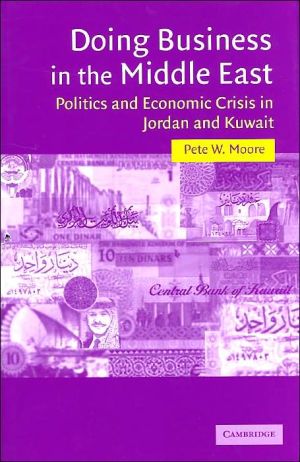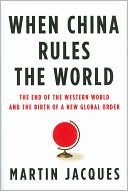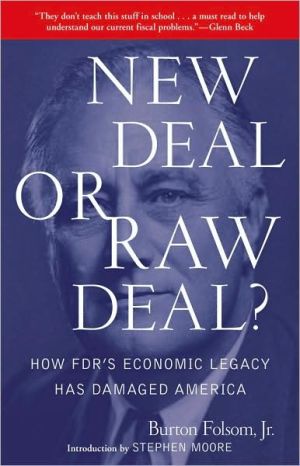Doing Business in the Middle East: Politics and Economic Crisis in Jordan and Kuwait (Cambridge Middle East Studies Series)
Is business the solution to the problems of the Middle East? Some economists and policymakers argue that unleashing the Arab private sector is the key to sustainable growth and more liberal politics. Pete Moore's book is the first to examine, systematically and historically, relations between state authority and elite business representation in the region. By analyzing the cases of Kuwait and Jordan, he considers why organized businesses in Kuwait have been able to coordinate policy reform...
Search in google:
The first book to examine relations between state authority and elite business representation in the Middle East.
\ Cambridge University Press\ 0521839556 - Doing Business in the Middle East - Politics and Economic Crisis in Jordan and Kuwait - by Pete W. Moore\ Excerpt\ \ \ \ \ 1 Summers of discontent: business-state politics in the Middle East\ \ \ \ August is not a pleasant month in Kuwait City. In the noonday heat, a cigarette lighter left in a car can burst into flames. Sandstorms arrive without warning, making immediate shelter vital. Understandably, August is a time many Kuwaitis choose not to remain in the country, giving the impression that politics is almost suspended during the summer months. How ironic, then, that two of Kuwait's most damaging political events, a massive fiscal collapse and invasion by Iraq's army, occurred in the month of August. These events were not unrelated. The crash of an extra-legal stock market, the Souq al-Manakh, in 1982 initiated a string of economic difficulties that would contribute to the Iraqi invasion nearly a decade later.1 To cope with the fiscal and political fallout from each, the Kuwaiti state turned to its private sector. The public-private struggle to respond to these events would require enduring many more Augusts.\ Kuwait, however, was not alone. Across the Middle East, declines in external sources of capital were testing state capacities to respond. Of all the Arab states, no other was tied to Kuwait's travails quite like the Hashemite Kingdom of Jordan. In addition to foreign aid from the West, Jordan was a major recipient of development aid from Kuwait. Hundreds of thousands of Jordanian professionals have worked in the public and private sectors in Kuwait since the 1950s. The same fiscal crisis that jolted Kuwait carried through to Jordan; and in the aftermath of Kuwait's liberation, those Jordanian workers were forced to return to Jordan. To deal with these crises, the Jordanian state also turned to its private sector. Decades of fiscal crisis and political struggle, therefore, have inexorably bound these two Arab countries. Moreover, the remedy each sought was oddly reminiscent of what the developmental economist Albert Hirschman argued long ago, "what lacks in late-late developers is not the capital to invest, but the will of entrepreneurs to invest."2 Central to this will is the status of relations between domestic business and the state. This book is about that relationship before, during, and after prolonged economic crisis. It seeks to explain variation in business-state relations and chart the political and economic effects that follow from such divergences.\ Kuwait's and Jordan's political-economic crises have been quite similar to those of other developing countries throughout the 1980s and 1990s. In contrast to the common perception that developing countries are only now opening to globalization, Jordan and Kuwait, like many states in the Middle East, have long been supine in the face of the dangers and fortunes of regional and international shifts. Following the optimism of independence and the soft budget constraints of the 1960s and 1970s, many states witnessed economic near-reversal in the 1980s and 1990s. In Africa and the Middle East, declines in exogenous revenue and persistent low economic growth rates have strained fiscal systems and induced chronic debt. Few Latin American countries escaped similar fiscal shocks, and even the Asian Tigers experienced crisis by the late 1990s. In tandem with global market shifts, demographic pressures in every developing country have made acute the need for more productive growth; that is, not merely greater economic expansion (higher output) but longer-term investment and developmentally nutritious private-sector expansion. The policy responses to and political effects of these pressures have not been uniform. Some states have pursued successful reform, some have retrenched, some have undergone regime change, and others continue to struggle with reform implementation. However, in almost every case, state officials have attempted to balance the need for increased domestic revenue with the desire to entice more private-sector investment and employment.\ In the Arab Middle East, similar economic dilemmas are set against varied political and social backgrounds. Compared with much of the developing world, the Arab states have weathered the economic crisis of the 1980s and 1990s with few of the expected political ramifications and virtually no meaningful democratization. Among the Arab states, however, variation in the extent of economic adjustment has been evident, albeit with no "Arab Tigers." Given that oil is a finite resource, the dawn of a new millennium may bring a rise in oil prices and perhaps some economic relief for debt-burdened Arab governments. However, if we are to understand and speculate on the region's economic future, we must first account for political-economic change during the crisis decades. By unpacking and examining change in business-state relations across two cases, this book's aim is to address a set of questions that explore a crucial element of state-society relations during economic crisis. How do business-state relations affect reform outcomes? Why do organized business representatives of some countries gain more voice in policy while others fail to gain influence? What effect does this specific state-society relationship have on broader political outcomes such as productive economic adjustment and political liberalization?\ These questions are not in the abstract. In the post-colonial Arab world, business elites have at times played prominent roles in demanding greater political representation, creating domestic economies, and resisting the consolidation of authoritarian rule.3 During those same years, however, private enterprises were sequestered in many countries, business elites were coopted through state patronage, and organized business representation was either bypassed or swallowed by an expanding public sector. Since the 1980s, the Arab private sector has made an institutional comeback as Arab states faced chronic fiscal crisis and persistent economic downturn. Why has this been the case? Because coping with these pressures requires states to craft economic reform policy, mediate domestic political influences, balance external pressures, and implement and monitor policy changes. The last two decades have clearly demonstrated that the Arab state cannot do all of this. The result, in nearly every Arab country, has been an increased role for private-sector actors at each of these stages. Almost everywhere associations of business representation have been resuscitated. In countries where business was either fully coopted or partially replaced (Syria, Egypt, Qatar, and Saudi Arabia), a combination of state-initiated openings and business reorganization has generated a louder voice for business and increased public-private coordination. In countries with a more historically resilient private sector (Kuwait, Yemen, Tunisia, and Morocco), business associations have come to play genuine roles in the formulation and implementation of economic policy. As some countries have gradually opened their political systems to wider participation, business has sought greater political representation and expression.\ Collectively these trends have encouraged a reappraisal of the Arab private sector. International lending agencies and consultants now call for deeper domestic reforms to "unleash the private sector."4 Popular journalistic accounts regularly tout Arab business as a natural counterweight to political Islam and a natural ally of Western ideals.5 Government officials in Washington have also jumped on the bandwagon and overtly tie increased private-sector activity with peace in the region. The trend is to join a revived private sector, market reform, Arab-Israeli peace, and the defeat of terrorism into one causal chain.6 Despite this advocacy and the growing comparative evidence that some form of public-private coordination is required for successful economic reform, the ability of Arab states and their private sectors to coordinate in their efforts toward reform has not been uniform.\ Peter Gourevitch best summed up the vexing logic present in such business-state engagement during crisis: "State action is frequently corporatistic, in that state and groups borrow from each other the authority to do what they cannot do alone."7 Political factors determine how the dilemma is addressed: in some cases business elites and state officials borrow enough to achieve sustained private-public coordination, while in other cases coordination remains elusive. The cases of Jordan and Kuwait exemplify these typical yet contrasting outcomes. Despite enduring decades of exogenously triggered fiscal crises, business-state coordination in reform attempts and business's ability to shape policy under fiscal crisis generally succeed in Kuwait, yet fail in Jordan. One can add to this divergence the counterintuitive theoretical aspect of such outcomes. Comparative political-economy literature privileging structural constraints and a country's revenue base posit that highly revenue-autonomous and sectorally dependent states, such as Kuwait, should experience either policy deadlock or policy drift as a result of resistant domestic business. Less dependent states, such as Jordan, should benefit from greater autonomy from business and an ability to implement unpopular reform.\ This book's explanation of divergence in the Jordanian and Kuwaiti cases seeks to build upon structural and incentive-based models of business-state relations. The sectoral nature and revenue characteristics of the modern Arab state are important first factors to study in assessing how business and state interact and under what conditions coordinated relations evolve; however, they are not sufficient. Shifts in a\ \ \ Table 1.1 Per capita GNP: constant US dollars\ \ \ \ \ 1972-1976\ 1976-1980\ 1980-1984\ 1984-1988\ 1988-1993\ \ \ \ \ Jordan\ \ 470\ 996\ 1,642\ 1,842\ 1,396\ \ \ Kuwait\ \ 7,854\ 17,104\ 20,392\ 15,366\ 14,053\ \ \ \ Source: World Bank, World Tables 1987 (Baltimore: Johns Hopkins University Press, 1987); World Bank, World Tables 1996 (Baltimore: Johns Hopkins University Press, 1996).\ country's revenue or sectoral profile (declines or increases in oil and aid, for instance) herald domestic political change, but the direction and type are not givens. For example, David Waldner argues that "the [rentier] thesis fails to distinguish between constraining conditions and permissive conditions; the presence of externally derived wealth makes certain arrangements possible but it does not dictate their establishment."8 The argument of this book proposes patterns of business-state relations as one set of constraining conditions on the ebb and flow of external revenue, an approach that requires attention above and below the level of the state. Divergence in the organizational nature of business representation (whether elite cohesion or breakdown) shaped the capacities of business elites to coordinate with public authorities during the exogenously driven crisis decades of the 1980s and 1990s. The pace and political terrain (i.e., the strength of the political opposition) during crisis determined state incentives toward coordination. Consequently, the task of my empirical analysis is to take account of how each country's business community evolved before and after European rule, how institutions of business representation changed over time, and how state actions vis-à-vis important social actors, such as business and political Islam, shaped the type and strength of political opposition during crisis. It is these factors that distinguish business-state relations in the region and ultimately shape future economic development and reform.\ \ Comparing cases and subjects\ At first glance, comparing Jordan, a lower-middle-income country, with Kuwait, one of the world's richest countries, seems a mismatch (see table 1.1). The differences are not trivial, but as candidates for comparing business-state relations Kuwait and Jordan exhibit key similarities: their histories as post-colonial Arab states, the presence of large, functionally similar business organizations, and the timing of economic growth and crisis.\ First, both are important Arab countries given their strategic locations, and each has been a regional leader in experimenting with political liberalization. Jordan and Kuwait both experienced British rule, which recognized and strengthened the local monarchies, and nurtured a new form of external dependence. The al-Sabahs in Kuwait and the Hashemites in Jordan have traditionally retained near-absolute political authority while hesitantly granting greater participation in formal politics over time. Jordan and Kuwait are small states, located in an insecure regional environment, and thus both monarchies relied on British and later American support (financial and military) to retain their power. Surrounded by large, aggressive neighbors, Jordan and Kuwait are equally sensitive to regional shifts and external threats. The two have exhibited similar ascriptive divisions and conflicting national identifications. In Kuwait, the distinctions run from the religious (Shi'a, Sunni), to citizenship status, to tribal affiliations and history. In Jordan, distinctions involve principally origin (West Bank or East Bank) but also include time of immigration to Jordan, tribal affiliation, and religious identification (Christian or Muslim). As well as these ascriptive similarities, Jordan and Kuwait also share a history of elected parliaments, constitutionalism, and self-identification as democratic states. In the context of Middle East domestic politics, the political leaderships in Kuwait and Jordan have historically cited their democratic nature in a bid for more external political legitimacy; and, by regional standards, political debate in these Arab countries is robust. In this way, Jordan and Kuwait are at the leading edge of political experimentation in the region and have much to offer as models for other regional liberalizers such as Bahrain, Yemen, Egypt, Morocco, Tunisia, and Oman.\ Second, since policy outcome - the degree to which the private sector and the state coordinate on policy reform - is a dependent variable, this book also examines how each business community represented private-sector interests to the state. The role of business associations in each case provides a generalizable comparative base. In each case, and indeed throughout the Arab world, business was the alpha wolf of societal organizers. Chambers of commerce were established long before state independence, and by the 1970s these institutions were the largest (as measured by membership) domestic social organizations in the region. Both the Jordanian and Kuwaiti chambers were founded on the Anglo-American interest-group model, as opposed to the more corporatist continental model; however, these demarcations between public and private have never been absolute. Neither association was founded as a reaction to a rival labor organization. Both have held free elections for leadership every four years since their founding, and each is financially autonomous from direct state authority. On these points, a key difference is apparent with business associations in Egypt, Saudi Arabia, and Syria, where state sponsorship and management have been prevalent since political independence. However, as liberalization and greater private-sector initiative are pursued throughout the Arab world, it is the Kuwaiti and Jordanian business associations that are sought out as models to emulate.9 A question remains, however: why focus on formal institutions when informal business-state clientelism may prevail?\ While it is true that business lobbying in the developing world is often assumed to take the form of individual rent-seeking, increasingly state officials prefer an aggregated voice. Dealing with an official representative not only provides legitimacy; it also saves the cost of canvassing individual firms and sectors. Surviving fiscal shocks and pursuing reform require flexibility and responsiveness, capabilities an institutional actor can provide. Especially in countries where state capacities are underdeveloped, "how the state and other coordinating mechanisms (e.g., markets, networks, associations) coalesce and are related to particular social systems of production are important determinants of economic performance."10 In the modern Middle East, business-state coordination is one of those mechanisms. Increasingly, in circumstances of protracted market uncertainty and fiscal volatility, institutional interaction is the preference. Moreover, as countries of the Middle East face rapidly shifting pressures from market globalization, what Philippe Schmitter terms the "continuous representation" of business associations can provide state officials with timely, clear signals on private-sector interests.11 Certainly, clientelism has not lost its uses and business representation has hardly come to dominate the reform agenda in every country; however, greater analysis is required of the changing dynamics of all aspects of public-private interaction.\ Finally, in a broader political sense, Arab business associations, by virtue of their comparative autonomy and long history of intra-electoral competition, have at times played the role of proxy political party. In Latin America, for instance, "the social classes that formed the historic base for parties have fragmented into specialized sectoral and professional clienteles that have sought new forms of collective expression."12 In most Middle Eastern countries, strong political parties were not institutional precursors to social organizations; rather, weak or non-existent party systems existed alongside the more established and more capable professional associations (al-Niqabat al-Mihaniyya), especially business associations. Thus, a focus on organized business grants insight into broader questions of changing patterns of state-society relations and the role interest associations may play in future political transitions.\ An additional issue of concern is the treatment of business (or any social actor) as monolithic rather than disaggregating its interests and actions.13 This study does not assume business as a monolith, nor is its purpose to address the business-state nexus from every vantage. A focus on the associational representation of business over time provides but one window into how a business community changes, how elites evolve, and why interests translate into action the way they do. Jeffry Frieden has termed this the "demand-side" approach to business politics. When interpreted together with the supply side, "This synthesis accepts that private interests are crucial inputs into policy-making and that the institutional context within which these interests are processed also has a substantial impact on outcomes."14 For this study, then, the terms "organized business" and "association" refer to the respective peak chambers of commerce. The terms "business community" and "business elites" will be explained in context to refer either to the rank and file of the chamber or to the leadership. Finally, this study does not focus upon small merchants or the large informal economies of the Middle East.15\ Third, the timeframe of comparison hinges on similar boom-and-bust patterns. A number of Middle East comparativists16 have successfully utilized this two-country approach, and this book attempts to follow in that tradition. Clearly, there are uses and limits to this or any comparative method;17 however, by juxtaposing the crisis period with the earlier periods of state-building and commodity boom, the elements of similarity and difference in business-state relations rise to the top. While the countries of the Middle East may provide little variation for those pursuing questions of democratization and regime change, focused and historically informed comparisons of economic development and state-society relations reveal rich variation among the Middle Eastern cases. Economically, both countries are late-late developers that have depended to a great extent upon inflows of capital. Kuwait cashed in on its resource endowment, while Jordan cashed in on its geostrategic position and expatriate labor. Some of the massive oil revenues received by the Kuwaiti state were channeled back to Jordan through remittance income and development aid. Tremendous inflows of capital fueled economic boom in the 1960s and 1970s. This aspect of the analysis bears a resemblance to Kiren Chaudhry's comparison of Saudi Arabia (oil rents) and Yemen (aid and remittance income). For Chaudhry, the different types of rent flows lead to different institutional arrangements between business and state and ultimately to contrasting forms of state autonomy in each case.18 Through a more sustained focus on the evolution of business in Jordan and Kuwait, the purpose of this study is to highlight the role played in the evolution of business-state relations in the periphery by other political and, particularly, institutional factors: specifically, the organization of business representation, the cohesion of business elites, and the challenge of political rivals.\ What became known as the bust period, the 1980s and 1990s, is the pivotal point of the comparison. It is in the period after the boom that the divergent patterns of business-state relations become most evident. For the comparativist, times of financial crisis provide excellent opportunities to see what really matters in a country's politics, since it is in such periods that political responses are clearest.19 Obviously the assumption is that the crises in the 1980s and 1990s are similar for both Jordan and Kuwait. Table 1.1 demonstrates the income aspect of the crises in terms of declining per capita GDP in the 1980s. While analysis will detail important contextual differences in the crises, pressure on each state to reform economically and court greater private-sector participation was comparable. Moreover, it was clear that the two states attempted to react similarly to the crisis but that each was institutionally unprepared to resolve the crisis. Both countries pursued political liberalization and economic reforms during the 1980s and 1990s. Declines in exogenous rents to each state brought depressed economic growth; thus both states have had to juggle the necessity of liberalizing economically and politically while maintaining centralized political control. Bracketing the business role in economic policy debate from its impact on political liberalization is clearly not possible. Therefore, using fiscal crisis as the comparative focus for Kuwait and Jordan broadens investigation into how business-state interaction on policy generates political externalities. The explanation for the comparative success of institutionally based business-state coordination in Kuwait in advancing economic reform and addressing chronic debt by the mid-1990s, in contrast to Jordan, also provides some insight into the stagnation and reversal of political liberalization in the same years. One conclusion from this study is that the changing relations between business and the state reflect the broader evolution of authoritarianism in the region.\ Consequently, while this book compares two countries, it does so at the level of state-society relations: specifically, patterns and change in the institutional mediation between business and state over time. Social science theories focusing on business-state relations are well developed and have keenly shaped how we view state-society relations in the developing world. Comparative scholarship of the countries of the Middle East provides material to test and correct these theories.\ \ A single logic, two approaches\ A goal of this study is to provide theoretically informed insight into business-state relations in the Arab world and generate correctives to some of the prevailing approaches to business-state politics in the developing world in general. Two interpretations that derive from a common intellectual heritage can be identified: theories arguing that business-state relations are shaped by dynamics at the state level and higher (termed structural/statist), and those that focus on the collective action of business from the bottom up (termed new institutional economics). Though structural approaches have succeeded in generating comparative work on Middle Eastern countries and the focus on institutions has broadened economic inquiry, both clusters of literature generalize about important aspects of the business-state relationship within a framework of neoclassical economics. Each approach relies on the assumption that the reaction of domestic business can be explained by reference to structured incentives. For structural/statist theorists those incentives are ultimately economic. For the more actor-centered, collective-action theorists, those incentives overlap with an organizational logic, yet are nevertheless grounded in material interests. In other words, each is an extension of the foundations of neoclassical economics into political analysis. One critique offered by this study is that, in approaching the subject from different directions but operating from the same assumptions, the micro and macro arguments commit the same original sin.\ \ \ \ \ © Cambridge University Press
1Summers of discontent : business-state politics in the Middle East12Organizing first : business and political authority during state formation303Politics and profits854Crises at century's end1205Is business the solution?176








